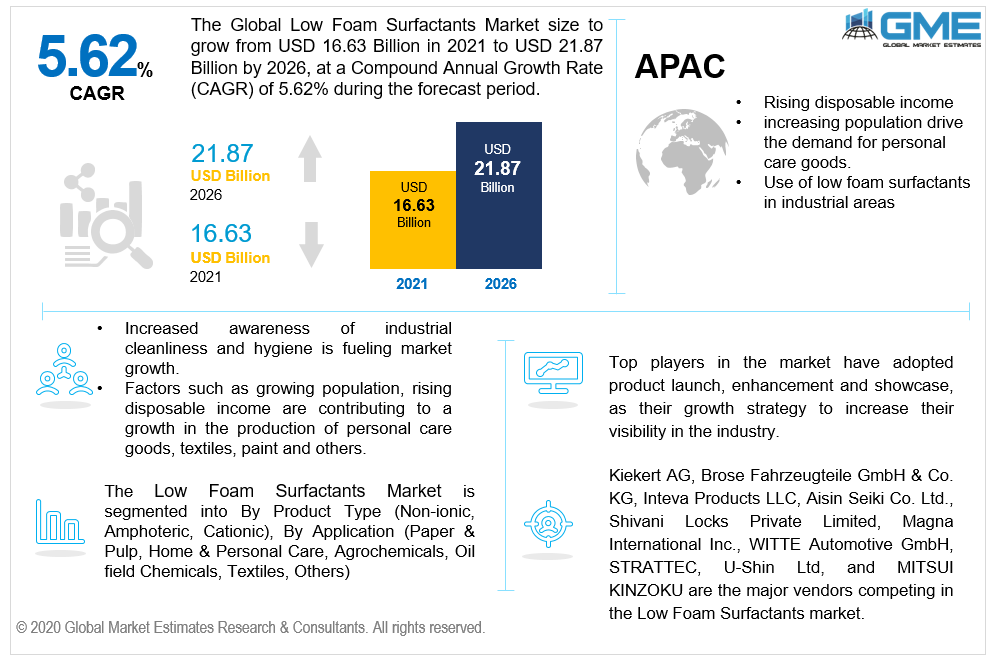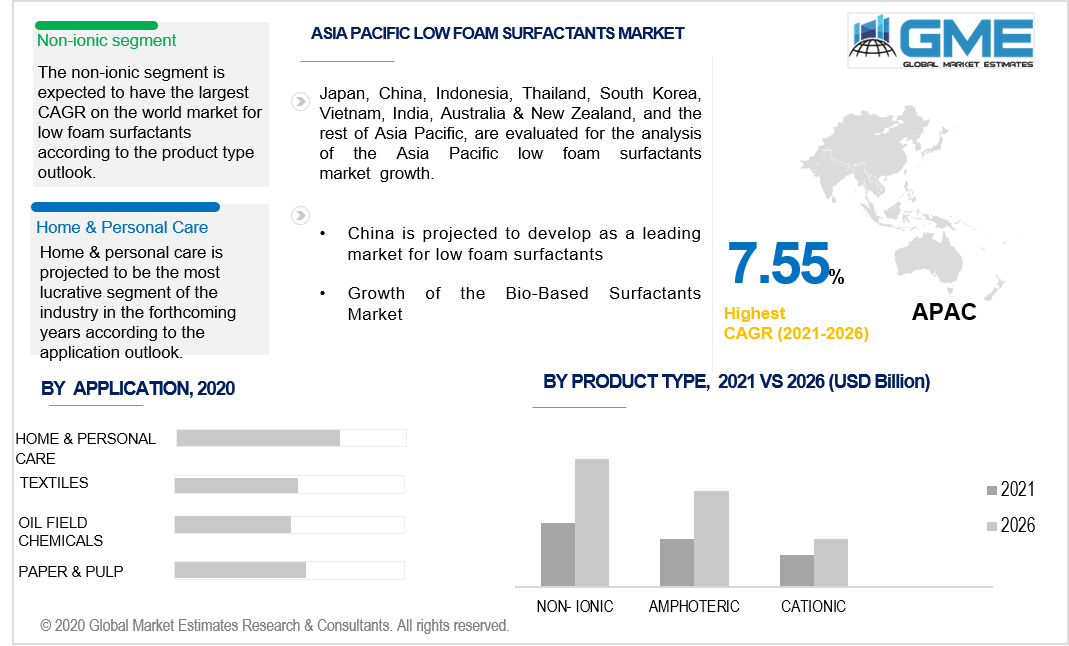
Global Low Foam Surfactants Market Size, Trends, and Analysis - Forecasts To 2026 By Product Type (Non-ionic, Amphoteric, Cationic), By Application (Paper & Pulp, Home & Personal Care, Agrochemicals, Oil field Chemicals, Textiles, Others), By Region (North America, Asia Pacific, CSA, Europe, and the Middle East and Africa); End-User Landscape, Company Market Share Analysis & Competitor Analysis
Surfactants are also known as surface-active agents which are majorly preferred in cleaning detergents. Surfactants increase surface activity that helps to eliminate the dust that is stuck on the bottom. Low foam surfactants are available in three forms namely cationic, amphoteric and non-ionic. Low foaming surfactants are commonly used due to their quick wetting properties of low foam formation and low dynamic surface tension.
There has been a growing demand in the low foaming industry for surfactants due to their wide usage in different industries such as paints, textiles, and personal care among others. The demand for low foam surfactants is expected to rise in the projected timeframe due to advancements in the efficiency of low foam surfactants. The growing need for improved coatings with increased efficiency and longevity and the need for more durable and greener surfactants has spurred the growth of the market for low foam surfactants. Also, increasing urbanization, a growing number of working women, change in the lifestyle of the people, and increasing awareness about skincare & hygiene are some of the other factors that are projected to play a crucial role in the growth of the low foam surfactants industry.
The changes in raw material prices along with growing ecological issues due to the toxicity of surfactants are likely to hamper the market growth. It is also expected that technical limitations resulting in problems relating to the industrial development of bio-surfactants would obstruct growth over the projected period. Over the forecasted timeline, the advancement of the bio-based surfactant industry and the growing use of low foam surfactants are expected to demonstrate growth prospects for the low foam surfactant market. The growing awareness and adoption of eco-friendly goods are also propelling the growth of biosurfactants in developed countries.

Based on the product type, the market is segregated and considered into cationic, non-ionic, and amphoteric among others. The non-ionic segment will have the largest share in the global market. Non-ionic surfactants are also used at different temperatures without the need for functionality. Thus, these surfactants are widely favored around geographic regions. Also, it is anticipated that the governments that promote eco-friendly policies would fuel demand growth for non-ionic surfactants. Increased usage of non-ionic surfactants in a broad variety of products, household detergents, including industrial processes, and hard surface cleaners, is expected to accelerate the growth of this market. Reducing reliance on crude oil and high prices and volatility in the supply of petrochemical products are expected to boost the market for non-ionic surfactants over the projected timeframe.
Based on the application, the market has been split into textiles, agrochemicals, home & personal care, oil field chemicals, and paper & pulp, among others.
Home & personal care is projected to be the most lucrative segment of the industry, with growing usage of these products among users. Increased demand in the home care market could be attributed to the increased use of surfactants in detergents, soaps, and household cleaners. Substantial use of low foam surfactants in industrial fields, including paints and textiles is likely to raise demand for low foam surfactants shortly. The strong demand for low foam surfactants from developing nations due to changing habits and increasing public awareness of personal hygiene.
Over the next seven years, the textile application segment is expected to see less demand. This is primarily attributed to the increasing replacement of other surfactants in the industry by other products. However, the growing usage of surfactants in other industries, such as detergents, personal care, soaps, and food is expected to push the market upwards.

In terms of the region, the global demand for low foam surfactants has been divided into Latin America, Europe, Asia Pacific, North America, and the Middle East and Africa.
Based on revenue, North America leads the global market due to strong sales of products. However, factors such as rising disposable income, shifting habits, and increasing population drive the demand for personal care goods and hence is driving market growth in the Asia Pacific. The growing usage of products in industrial areas is boosting regional growth.
China is projected to develop as a leading market, due to rapid industrialization. Also, it is projected that major countries such as China, South Korea, and Japan will create substantial growth prospects for low foam surfactants in the coming years. In emerging economies such as China and India, low production and labor costs have pushed many business players with bases in developed economies to transfer them to emerging economies to attain economies of scale.
Kiekert AG, Brose Fahrzeugteile GmbH & Co. KG, Inteva Products LLC, Aisin Seiki Co. Ltd., Shivani Locks Private Limited, Magna International Inc., WITTE Automotive GmbH, STRATTEC, U-Shin Ltd, and MITSUI KINZOKU are the major vendors competing in the Low Foam Surfactants market.
Please note: This is not an exhaustive list of companies profiled in the report.
The main strategy adopted by most of the market players is new product development. Besides, some of the key tactics used by industry leaders are likely to be mergers and acquisitions, joint partnerships, combined with powerful marketing strategies. For product differentiation and marketing, media platforms are predicted to be used on a wide scale.
We value your investment and offer free customization with every report to fulfil your exact research needs.
The Global Low Foam Surfactants Market has been studied from the year 2019 till 2026. However, the CAGR provided in the report is from the year 2021 to 2026. The research methodology involved three stages: Desk research, Primary research, and Analysis & Output from the entire research process.

The desk research involved a robust background study which meant referring to paid and unpaid databases to understand the market dynamics; mapping contracts from press releases; identifying the key players in the market, studying their product portfolio, competition level, annual reports/SEC filings & investor presentations; and learning the demand and supply-side analysis for the Low Foam Surfactants Market.

The primary research activity included telephonic conversations with more than 50 tier 1 industry consultants, distributors, and end-use product manufacturers.

Finally, based on the above thorough research process, an in-depth analysis was carried out considering the following aspects: market attractiveness, current & future market trends, market share analysis, SWOT analysis of the company and customer analytics.

Tailor made solutions just for you
80% of our clients seek made-to-order reports. How do you want us to tailor yours?
OUR CLIENTS